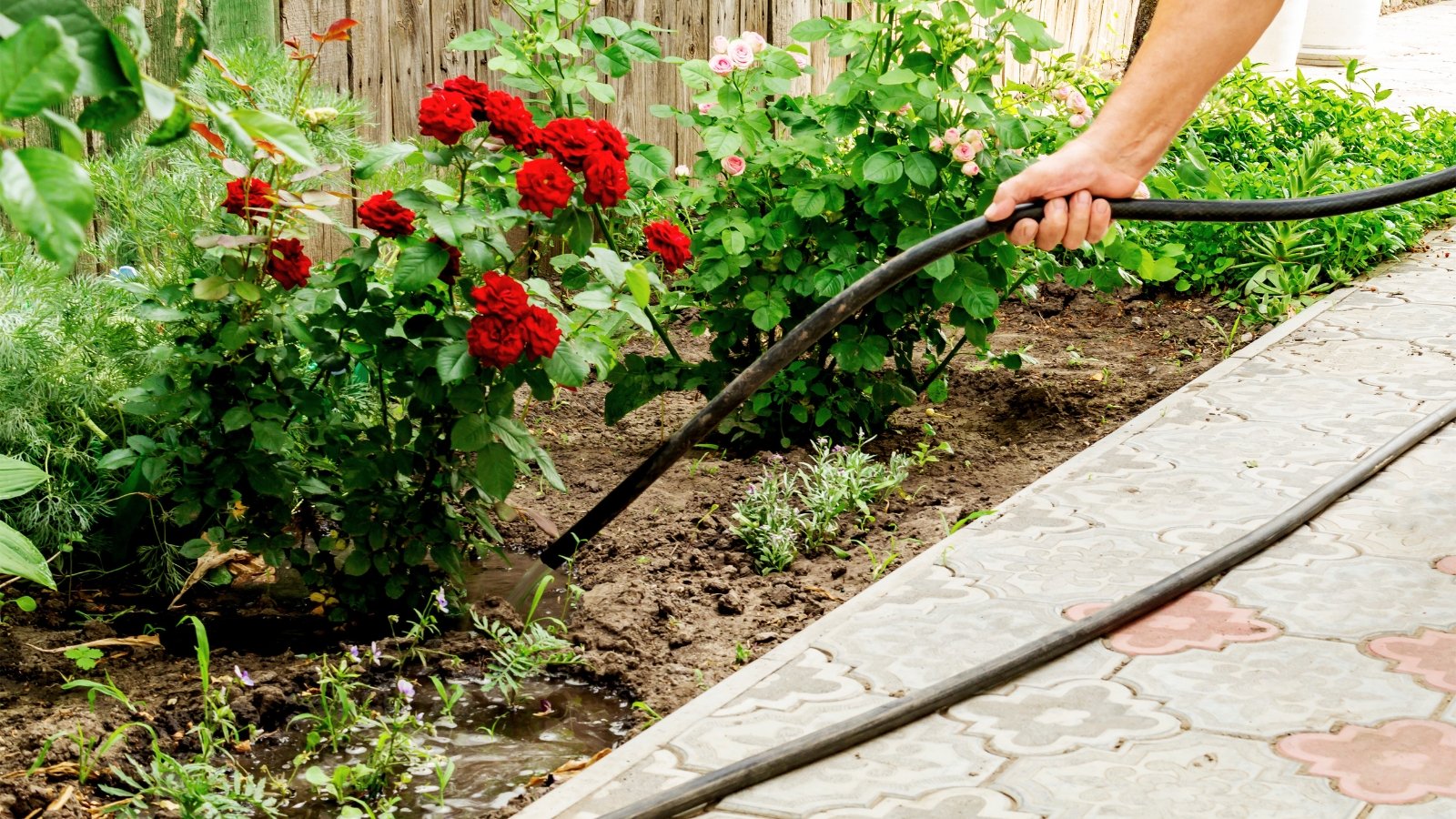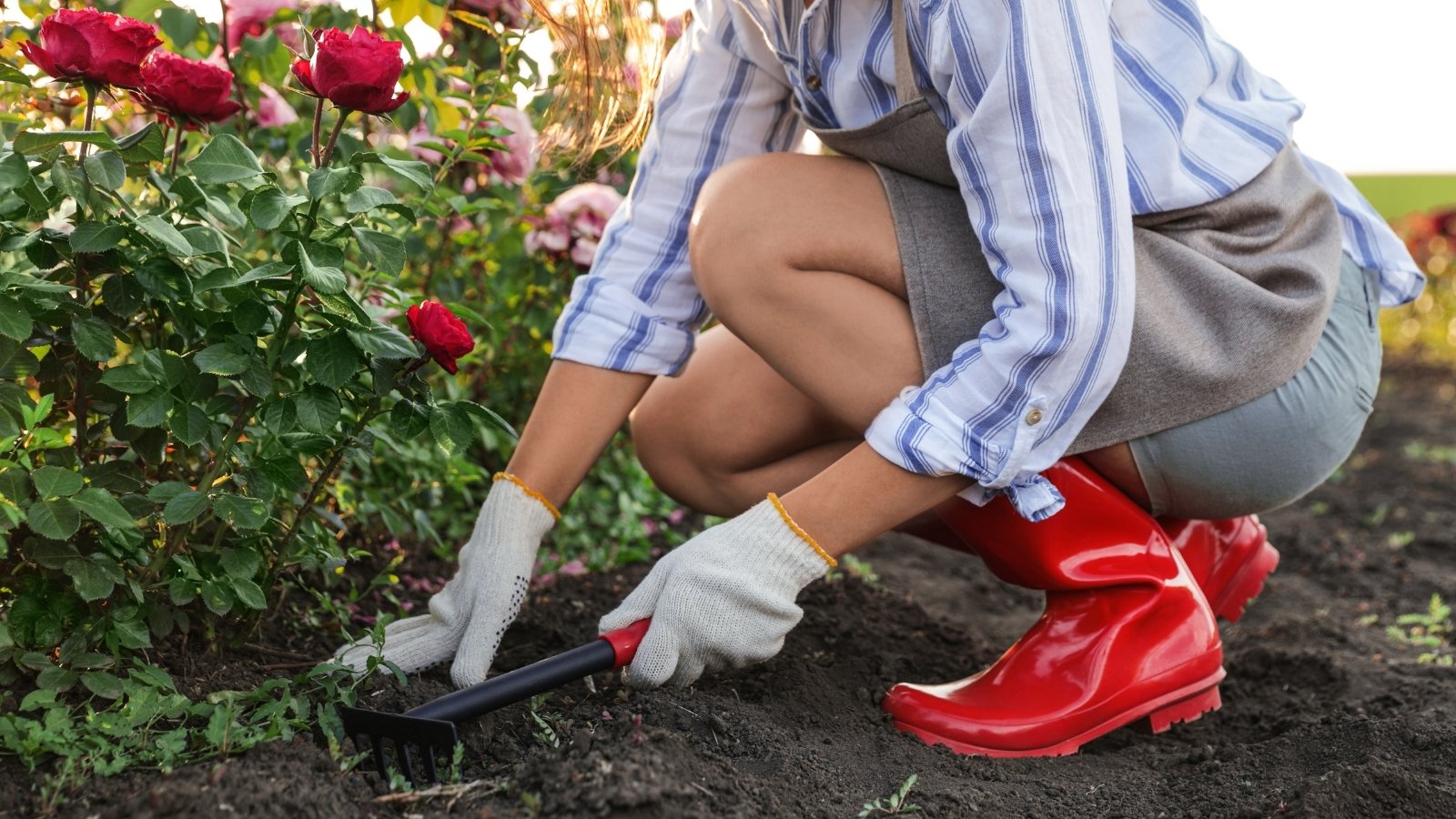5 Tips for Watering Your Roses This Summer
Roses, poised for continued growth and flowering in the warming temperatures of late spring and early summer, thrive with a few key watering techniques and cultural practices. Garden expert Katherine Rowe offers tips for summer watering to keep roses flourishing this season and beyond.

Contents
Roses, the queen of flowers, aren’t as dramatic to care for as their gorgeous blooms imply. They make adaptable and relatively easygoing plants with the proper plant selections and cultural practices.
Summer tests this idea as pests become active, heat and humidity increase, and seasonal extremes stress both plants and gardeners. Water requirements increase incrementally during summer to support active growth and flourishing blooms. Too much water, though, inhibits healthy plant development. The goal is to achieve evenly moist soils around roots for the best rose growth.
With established plants, we needn’t worry too much. A thriving, mature rose sustains itself with average rainfall and even withstands drought. It appreciates evenly moist soils and supplemental irrigation during prolonged dry spells. Newly planted shrubs need regular water to develop robust roots for healthy growth.
Knowing how much to water roses, the best watering methods, and the optimal time to water help ensure overall plant health and the best flowering. Understanding the local soil and accounting for seasonal variations is also useful. Here, we’ll explore tips for success in watering roses throughout the summer season.
Give the Right Amount of Water

Roses grow most actively in spring through early fall. They need less water in mild conditions than in summer, when temperatures rise. On average, roses need one to two inches of water per week, which is the equivalent of two to three gallons of water per plant. During summer heat and dry spells, increase water amounts to as much as five gallons (two to three inches of weekly water) and increase watering frequency as your water resources allow.
Water deeply and regularly rather than shallowly and frequently. Roses benefit from a good, steady soaking to reach all the roots and moisten the surrounding soil. Deep watering promotes root development for vigorous, long-lived plants that withstand variable conditions. Robust roots also absorb more water and nutrients for the plant.
Frequent, shallow watering causes roots to grow laterally, spreading just beneath the soil surface rather than reaching deep into the soil. Shallow roots impact plant stability, hardiness, and nutrient sources.
Use Watering Methods that Promote Rose Health

While there are many recommendations for watering roses, the way we water often depends on our existing garden resources. To prevent diseases and pests, the recommended method is to water at the base of the plant at the soil level.
Explore Watering Techniques

Watering at the plant’s base, slowly and deeply, allows water to saturate roots and soil during hot summer days. A watering can, bubbler fitting on a hose, drip irrigation, or soaker hose allows the consistent delivery of water at low volumes.
Overhead watering and the routine splashing of leaves and flowers can spread fungus and bacteria among leaves and from plant to plant. We know these shrubs benefit from rain, so overhead water is not detrimental; it just contributes to a damp environment for pests and diseases that thrive in humid conditions.
If overhead watering from sprinklers and spray heads is your reliable irrigation option, it’s best to water in the morning. Leaves dry in the day’s sunshine and breezes. Skip watering on overcast days and refrain from evening watering for the best defense against plant problems.
To deter and displace insects in their active season, spray plants with a jet stream of water once weekly or as needed during the summer. As with overhead irrigation, spray in the morning so foliage dries out during the day.
Check Soil Moisture

Medium soil moisture is best for these flowering shrubs, and a simple touch test helps us learn if we’re watering too much or too little. Dig knuckle-deep (about one inch) into the soil to determine whether it feels dry, wet, or just right. When the soil feels dry to the depth of one inch, it’s time to water.
Checking soil moisture regularly and observing the shrubs is the best way to determine the watering sweet spot. Underwatered roses wilt, and leaves turn yellow and crisp. They also wilt during periods of extreme heat, even in moist soils, and the soil touch test helps narrow down the cause. Leaves also turn yellow in cases of overwatering, but instead of being crisp, they’ll be soft and spongey.
Find the Best Time to Water

With any rose watering method, watering early in the day is ideal to prevent diseases like powdery mildew and blackspot. Morning water gives leaves, flowers, and stems a chance to dry in the sunshine.
Early watering also provides resources for the shrub during the heat of the day. They’ll benefit from the deep soaking before water evaporates from the soil and before transpiration (natural water loss through pores in the leaves).
Know Your Soil

Understanding local soil types is helpful for efficient irrigation. How local soils absorb and retain water plays a significant role in the amount of water these shrubs need. While organically rich soils are preferable, roses grow in a variety of less-than-ideal soil conditions. Well-draining soils are optimal for rose health.
A simple soil test, conducted through your local university extension service or on your own, helps determine whether the soil is clay, loam, or sand. Clay, loam, and sand have different absorption and retention rates.
Soil Types

Clay soils absorb water slowly and hold water longer. They require a lot of water to penetrate deeply but tend to lean overly wet.
Sandy soils, on the other hand, absorb water quickly and drain quickly. They dry out fast and benefit from watering deeply and more often.
Loamy soils are best for roses and many other plants. They are high in organic matter and allow for aeration, moisture retention, and good drainage.
In sandy or clay soils, incorporate three to six inches of compost derived from completely broken-down plant material. Compost helps with soil aeration, moisture retention, drainage, and nutrition.
Consider Summer Conditions

For many gardeners, summer is a time of extreme temperature and variable conditions, including rainfall. With ample rain, your rose bushes don’t need supplemental watering. Reduce or stop watering sessions during rainy weeks.
Add a session or two of deep weekly watering during dry spells, windy conditions, and intense heat. Watering these plants deeply two to three times a week in the summer works toward even soil moisture.
Final Thoughts
Regular watering in the summer gives these beautiful shrubs the best foundation for healthy growth and flowering. This includes rainfall, with little supplemental water needed for established plants except during dry spells.
Established shrubs are well-suited to the garden microclimate and the local soil. They withstand variable seasonal conditions better than newly planted roses, which benefit from more frequent watering sessions. Aim for evenly moist soils and water deeply to promote a robust root system. The right rose in the right spot is an adaptable grower, ready to bloom with abandon.










